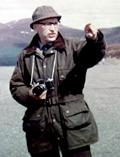
|
|
|
Dick's life with physics, page 7 |
|
|
|
|
|
1975 was the year of Professor Feather's retirement. To honour his contribution to teaching, IUPAP decided to hold its International Conference on Physics Education, funded by UNESCO, in Edinburgh for 3 weeks in July of that year. Dick was asked to organise the local input. He agreed only out of respect and affection for Feather, for he had little interest in the educationalists' jargon-ridden approach to the subject and felt it was a colossal waste of the department's time. Fortunately senior lecturer Peter Kennedy was more excited and enjoyed the committee work and meeting with Tony French and Ed Taylor from the U.S. whose textbook on Waves and Vibrations was being used for the second year class. With Alastair Rae as a very efficient Secretary and help from the department's Francis Barnes, Ken Bowler, Richard Nelmes and Murray Campbell, and Archie Campbell from Napier College, among others, the event was a great success. It was a glorious summer. Most of the 330 participants, and many 'accompanying members', were housed and fed in Pollock Halls and various entertainments were laid on for them there. Winifred arranged outings, and one-to-one meetings between the 'accompanying members' and wives of members of the department. At a final reception in the Upper Library Dick was delighted to share the hand-shaking with the Principal of the University, Sir Hugh Robson, an old friend from his youth. Norrie Robson's father had been excise officer for Langholm, the district neighbouring Dick's father's territory of Lockerbie and Dumfries, and Dick as a student shared Norrie's digs in East Preston Street (their landlady always made sure they ate kippers before going out on a date). Dick did in fact meet a few congenial participants at ICPE, in particular astrophysicist Denis Coates from Australia who was at the time working in Milton Keynes on a new Open University course, S291: Images and Information. Later, Dick was external assessor and consultant for many years for that course, and gave considerable input to its re-write for 1992. Dick had long been aware of the need for a book at final year physics undergraduate level which would show how the new trends in optics were rooted equally in traditional optics, statistics, and quantum theory. By 1977 he had completed a text in draft, save for half of the final chapter and the whole of one appendix. A publisher was interested, but Dick felt no confidence that he could complete the work in the suggested time and would not sign a contract. For several years from 1977 Dick served on the committee of the Optical Group of the Institute of Physics. In 1981 he was invited to join the Editorial Board of Optica Acta by Lionel Baker of NPL, and remained on the board when it became Journal of Modern Optics under the editorship of Peter Knight, retiring in 1997. In the late 1970s Dick shared supervision of PhD student Isa Daudpota with fluid dynamicist Clive Greated, in a study of particle image velocimetry. He also introduced an honours option on Modern Optics. Gold star for Dick Sillitto was the verdict of one of those who chose it in 1980, outstanding among them Karen Ness and Will Hossack. Karen went on to Imperial College and in 1996 became pioneering Chief Executive of the Institute of Photonics at Strathclyde. Astronomer Alison Campbell remembered Dick's "electrifying, totally unforgettable" demonstration of two-slit interference at very low light levels as The most beautiful experiment. And a graduate from 1982, later a schoolteacher remembering the course which introduced him to an extra layer of beauty behind the rainbow, recalls: It is the last lecture of optics in second year. We have been told to expect something special. We expect a gimmick - holography perhaps. Instead, Dick resolves the sodium D lines on the ceiling of the lecture theatre. We go away wowed. |

|
| Site index |